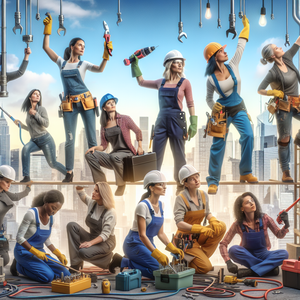New Faces on the Jobsite: How Infrastructure Spending is Diversifying the Skilled Trades

For years, the skilled trades have grappled with a shrinking and aging workforce. The U.S. Bureau of Labor Statistics reports that nearly one in four construction workers is aged 55 or older, and retirements are accelerating faster than new entrants can fill the gap. Meanwhile, the demand for skilled workers is booming. Driven by federal policies such as the Infrastructure Investment and Jobs Act (IIJA), states and local governments are launching a wave of new projects, fueling a hiring spree for electricians, welders, heavy equipment operators, and construction managers. This urgent need for talent has prompted companies, unions, and workforce agencies to expand recruitment beyond traditional sources. By proactively seeking out underrepresented groups, they are not only filling vacancies but also bringing fresh skills and perspectives into the trades.
Women Breaking Ground
Women have long been underrepresented in construction and related trades, historically comprising less than 4% of the workforce. However, that number is slowly climbing as organizations and employers invest in outreach, support, and training. The National Association of Women in Construction, for example, offers mentorship, networking, and educational opportunities designed to help women succeed in these fields. Local apprenticeship programs are also making concerted efforts to recruit and retain female candidates. Personal stories highlight this progress. Angela Hernandez, once a retail manager, now operates heavy machinery on a Texas highway expansion. Studies back up her experience—diverse teams are often safer and more productive, thanks to a broader range of problem-solving approaches and enhanced communication.
Veterans Find a New Mission
Veterans have always brought discipline, teamwork, and technical skills to civilian jobs, but the skilled trades offer a particularly strong fit. Programs like Helmets to Hardhats help veterans transition from military service into construction, utilities, and transportation careers by connecting them with apprenticeships and job opportunities. Take Marcus Lee, a former Army engineer, who now works as an apprentice electrician. Employers increasingly value the leadership, logistics, and project management experience that veterans bring—skills that are vital as infrastructure projects grow more complex and technologically advanced.
Career Changers Bring New Perspectives
The COVID-19 pandemic triggered a wave of career re-evaluation, prompting many Americans to leave office jobs for more stable and tangible careers in the trades. Community colleges and workforce development agencies have seen a surge in enrollment from mid-career professionals—including teachers, chefs, and even marketing executives—looking to retrain for hands-on roles. These career changers are infusing worksites with fresh perspectives, from innovative problem-solving to stronger communication and customer service skills. Their diverse backgrounds help break down traditional hierarchies and encourage a more collaborative, inclusive work environment.
Building a Workforce for the Future
To make the most of this demographic shift, industry leaders are investing in initiatives designed to support and retain new talent. Mentorship programs, flexible training schedules, and family-friendly benefits are being rolled out to make skilled trades careers more accessible and sustainable. Public campaigns and media stories are also working to change public perceptions—showcasing the skilled trades as modern, respected, and full of opportunity. The results are clear. A more diverse workforce is not only filling urgent labor gaps but also making the industry more innovative, safer, and better equipped to meet the evolving demands of infrastructure projects. As the skilled trades adapt to embrace new talent, they are also laying the foundation for a more equitable and resilient future.
Today’s infrastructure boom is doing more than just rebuilding roads and bridges—it’s rebuilding the American workforce itself. The skilled trades are opening their doors to women, veterans, and career changers, offering them not just jobs but meaningful, well-paid careers with room for advancement. In turn, these new faces are revitalizing the trades, bringing new ideas, energy, and perspectives that are reshaping the culture of the industry. As the nation invests in its future, the skilled trades are proving that diversity and inclusion are not just ideals—they are essential tools for building a stronger, more sustainable America. The transformation is underway, and the future of the trades has never looked brighter.
Infrastructure Project Manager – Public Works
City governments, AECOM, Jacobs, Skanska, Kiewit
Responsibilities
Oversee large-scale infrastructure projects (e.g., highways, bridges, water treatment) from planning to completion
Ensure adherence to timelines, budgets, and safety regulations
Key Skills
Strong background in civil engineering or construction management
Proficiency in project management software (e.g., Primavera, MS Project)
Excellent stakeholder communication
Qualifications
Bachelor’s degree in engineering or construction management
Several years of field experience
PMP certification is often preferred
Heavy Equipment Operator – Highway & Civil Construction
Granite Construction, local departments of transportation, infrastructure subcontractors
Responsibilities
Operate machinery such as excavators, bulldozers, and cranes on road, bridge, and utility projects
Perform daily equipment checks and basic maintenance
Key Skills
Technical aptitude for diverse equipment
Strong situational awareness
Strict adherence to safety protocols
Qualifications
Completion of a registered apprenticeship or vocational program
Commercial driver’s license (CDL) often needed
Apprentice Electrician – Renewable Energy Installations
NextEra Energy, SunPower, IBEW locals
Responsibilities
Install, maintain, and troubleshoot electrical systems in solar farms, wind turbines, and energy storage facilities under supervision
Key Skills
Understanding of DC/AC circuitry
Familiarity with electrical codes (NEC)
Ability to interpret technical blueprints and schematics
Qualifications
Enrollment in a recognized apprenticeship program
Military veterans often leverage technical backgrounds for accelerated placement
Construction Safety Coordinator – Diverse Jobsites
General contractors, safety consulting firms, Department of Labor
Responsibilities
Develop and enforce health and safety protocols
Conduct site inspections
Lead incident investigations on active construction projects
Key Skills
In-depth knowledge of OSHA standards
Strong communication skills for diverse teams
Experience delivering training sessions
Qualifications
OSHA 30 certification
Prior field experience
Backgrounds in military or emergency services are valued
Workforce Development Specialist – Skilled Trades Outreach
Workforce boards, community colleges, trade unions, Helmets to Hardhats, National Association of Women in Construction
Responsibilities
Design and implement recruitment, training, and mentorship programs targeting underrepresented groups for skilled trade careers
Key Skills
Program management
Community engagement
Partnership-building with unions and educational institutions
Data analysis for tracking outcomes
Qualifications
Bachelor’s degree in workforce development, education, or a related field
Prior experience in career counseling or recruitment is advantageous


